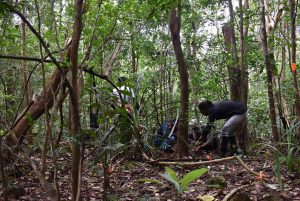A new plant comes up only when the seed manages to grow new roots and shoots where it lands. This is called seedling recruitment.
What happens after dispersal? Where a seed lands is often the first step in deciding how well an individual will do. A seedling to survive and grow is the first step for a tree to be. For many forest seedlings, life is dark in the undergrowth. With less light, you can’t photosynthesize, so you can’t grow. As the climate gets drier, the canopy opens up. Seedlings now have light, but when rain is limited to short parts of the year, seedlings need to live through periods of scarce water (drought). If you are a seedling in a savannah, you also have to contend with grasses that use up resources quickly and grow much faster than you. If you live in the temperate or boreal regions, you have to survive the harsh winter cold and frost.
The conditions across large spatial scales, e.g., differences in rainfall and seasonality, shape biomes found in different climates. Even within a smaller area though, some places will be worse for a seedling than others—maybe because there is less water, light, or nutrients in the soil. Some individuals just cannot survive under some conditions, even if there is no competition from other seedlings. This is called environmental filtering.

Not all species can do well in all places. Where you end up depends on your intrinsic features that relate to form and function. Ecologists call these features ‘functional’ traits. Plant species differ in their traits. Some grow deeper roots, others have larger leaves. Deeper roots help where water is less in the soil. Wide, thin leaves help when there is more sunlight for photosynthesis. Thicker leaves photosynthesize slower, but may tolerate attacks from insects and fungi better than thin leaves. Defense also depends on making chemicals that can deter pests and pathogens. Traits can be physiological – how efficiently a plant uses water, converts light to carbohydrates, or exchanges gas and water across its stomata during photosynthesis.
In fact, it is not just that species differ in their traits. Scientists are now revisiting the importance of the classic idea that not all individuals are equal. Variation among individuals of a species can decide where species eventually end up, whether they do well only in specific circumstances or tolerate a range of different environmental conditions. Scientists are testing the idea that species that vary more among their individuals may be able to persist in many more sites across different environmental conditions. These findings can help us predict the impact of climate change on species.
Once a seedling does manage to get its roots down in a place, there is competition. You have a whole bunch of other seedlings, especially in wetter forests, that are trying to do the same things as you. Not all seedlings are equal, even those of a species that are otherwise so similar. Mostly though, it is different species that differ from each other in how much water, light and nutrients they need. If seedling A can survive and grow with less water than seedling B, then A will do better in dry places. But, if A needs more sunlight than B to photosynthesize, then B will do better in shaded conditions. So, when different parts of the forest vary in the conditions, different species of seedlings will be able to make a home there. On the whole then, the forest will contain a diversity of species, even though some may be more abundant than others.
Light and water are just two dimensions – when you throw in nutrients, soil conditions, pathogens – things get very complex very soon! That’s what makes the life of trees so fascinating to study. As ecologists, we try to understand how all of these factors determine which species is found in an area and how the combination of factors leads to differences in the community of trees in site X vs. site Y.
Competition doesn’t stop with your seedling neighbors. To top it all, you have older trees around you to compete with. Life is hard for the tiny seedling! Older trees make things tough in two ways: first, they just use up more resources. Second, they harbor disease-causing organisms like fungi and bacteria. So, you see, the neighborhood of an individual matters a lot to its success. We will read next about how that happens.